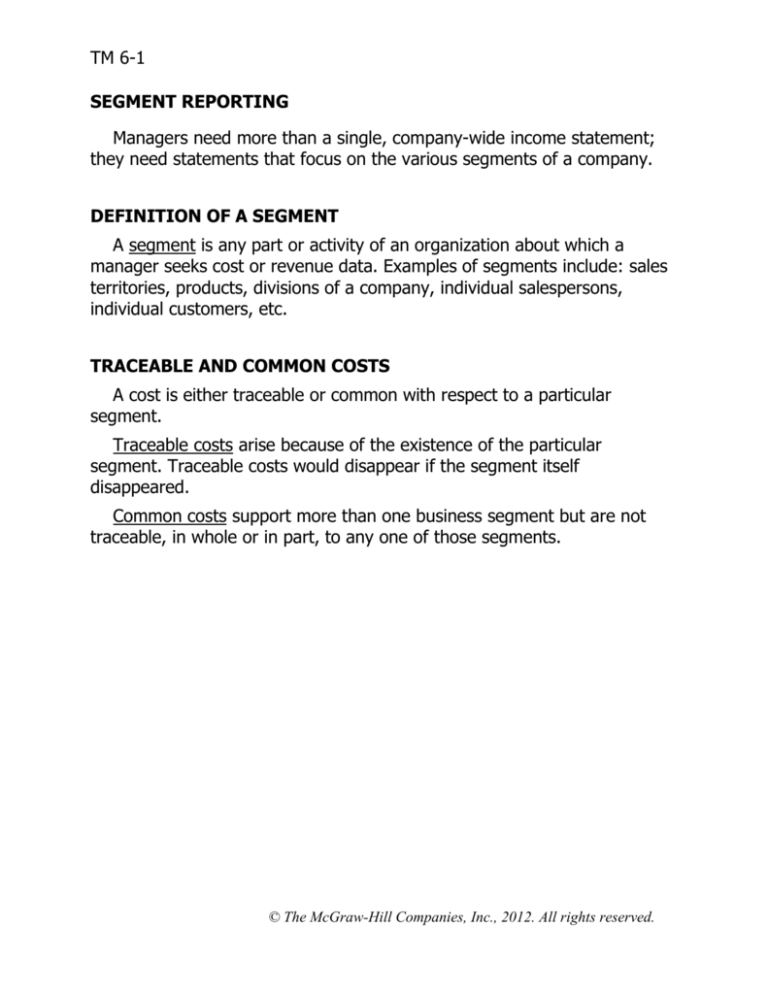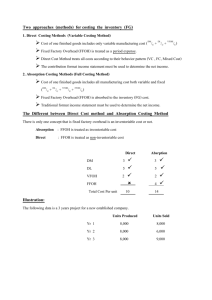
TM 6-1
SEGMENT REPORTING
Managers need more than a single, company-wide income statement;
they need statements that focus on the various segments of a company.
DEFINITION OF A SEGMENT
A segment is any part or activity of an organization about which a
manager seeks cost or revenue data. Examples of segments include: sales
territories, products, divisions of a company, individual salespersons,
individual customers, etc.
TRACEABLE AND COMMON COSTS
A cost is either traceable or common with respect to a particular
segment.
Traceable costs arise because of the existence of the particular
segment. Traceable costs would disappear if the segment itself
disappeared.
Common costs support more than one business segment but are not
traceable, in whole or in part, to any one of those segments.
© The McGraw-Hill Companies, Inc., 2012. All rights reserved.
TM 6-2
SEGMENT REPORTING EXAMPLE
EXAMPLE:
Mary Fischer, the owner of Mary’s Market, would like information
concerning the performance of the Market’s two main segments—the meat
and produce departments.
The following partial list of costs was provided to help identify fixed and
variable and traceable and common costs:
Meat Department
Produce Department
• Variable
costs
• Wholesale cost of meats • Wholesale cost of
produce
• Packaging materials
• Plastic bags and ties
• Traceable
fixed costs
• Meat department
manager’s salary
• Butchers’ wages *
• Meat department
depreciation *
• Rent on meat
department spaces**
• Common
fixed costs
• Produce department
manager’s salary
• Workers’ wages *
• Produce department
depreciation *
• Rent on produce
department spaces**
• Rent on space occupied by general
offices, checkout counters, etc.
• General manager’s salary
• Accountant’s salary
• Checkout clerks’ wages
• Liability insurance premiums
* Depending on circumstances, all or part of the indicated costs could be
variable.
** This assumes that the rent costs would be avoided if the department
were eliminated.
© The McGraw-Hill Companies, Inc., 2012. All rights reserved.
TM 6-3
SEGMENT REPORTING EXAMPLE
Sales .........................................
Variable expenses .......................
Contribution margin ....................
Traceable fixed expenses ............
Department segment margin .......
Common fixed expenses not
traceable to departments..........
Net operating income .................
Sales .........................................
Variable expenses .......................
Contribution margin ....................
Traceable fixed expenses ............
Product line segment margin .......
Common fixed expenses not
traceable to product lines .........
Department segment margin .......
Total
Company
$1,500,000
810,000
690,000
400,000
290,000
Departments
Meats
Produce
$900,000
460,000
440,000
230,000
$210,000
$600,000
350,000
250,000
170,000 *
$ 80,000
240,000
$ 50,000
Produce
$600,000
350,000
250,000
100,000
150,000
Product Lines
Fresh
Packaged
Produce
Produce
$400,000
200,000
200,000
40,000
$160,000
$ 200,000
150,000
50,000
60,000
$ (10,000)
70,000
$ 80,000
* The $170,000 in traceable fixed expenses for the Produce Department
changes to $100,000 traceable and $70,000 common expenses when the
Produce Department is further segmented by product lines.
© The McGraw-Hill Companies, Inc., 2012. All rights reserved.
TM 6-4
DANGERS IN ALLOCATING COMMON COSTS
Common costs should not be allocated among segments. If common
costs are allocated, the results can be misleading.
EXAMPLE: Suppose the common costs of Mary’s Market were allocated on
the basis of sales (a frequently used allocation basis).
Sales ...........................................
Variable costs ..............................
Contribution margin .....................
Traceable fixed costs ....................
Divisional segment margin ............
Allocated common fixed costs .......
Net operating income ...................
Total
Company
$1,500,000
810,000
690,000
400,000
290,000
240,000
$ 50,000
Product Lines
Meats
Produce
$900,000 $600,000
460,000
350,000
440,000
250,000
230,000
170,000
210,000
80,000
144,000
96,000
$ 66,000 $(16,000)
If the Produce Department were closed down because of its apparent loss,
the company would suffer an overall loss as shown below:
Sales ...........................................
Variable costs ..............................
Contribution margin .....................
Traceable fixed costs ....................
Divisional segment margin ............
Allocated common fixed costs .......
Net operating income ...................
Total
Company
$900,000
460,000
440,000
230,000
210,000
240,000
$(30,000)
Product Lines
Meats
Produce
$900,000
460,000
440,000
230,000
210,000
240,000
$(30,000)
—
—
—
—
—
—
—
© The McGraw-Hill Companies, Inc., 2012. All rights reserved.









